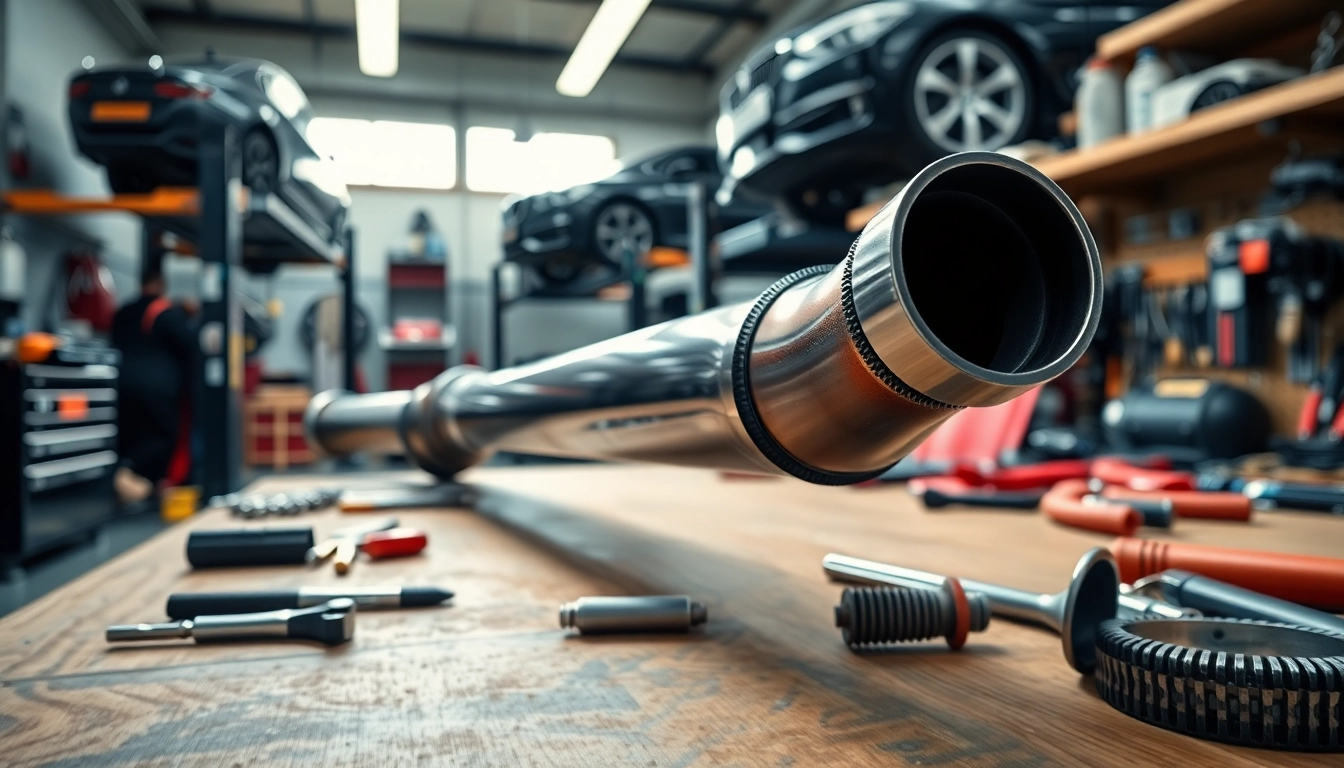Understanding the n55 Catless Downpipe
What is an n55 Catless Downpipe?
The n55 catless downpipe is a significant aftermarket part for performance-oriented BMW models equipped with the N55 engine. Unlike traditional downpipes that include a catalytic converter to reduce harmful emissions, a catless downpipe eliminates this component. This modification is popular among enthusiasts who seek improved exhaust flow and enhanced engine performance, allowing for greater horsepower and torque gains compared to stock options.
How Does a Catless Downpipe Work?
At its core, the functionality of a catless downpipe pivots on facilitating unrestricted exhaust flow from the turbocharger to the rest of the exhaust system. By removing the catalytic converter, which traditionally restricts exhaust gases to minimal emission levels, the catless downpipe allows exhaust gases to exit more freely. This process minimizes back pressure, enhancing turbo spool time and overall engine efficiency. Additionally, because these downpipes typically feature larger diameter tubing and smoother bends, they further assist in optimizing airflow.
Benefits of Using an n55 Catless Downpipe
Utilizing an n55 catless downpipe comes loaded with benefits:
- Increased Power Output: The primary advantage is the increase in horsepower and torque. Many users report significant improvements in performance metrics post-installation.
- Enhanced Turbo Response: With reduced back pressure, the turbocharger can spool faster, leading to improved throttle response and acceleration.
- Weight Reduction: Removing the catalytic converter can also decrease the overall weight of the exhaust system, further contributing to performance.
- Better Sound and Exhaust Note: Catless downpipes amplify the sound of the engine, providing a more aggressive and sporty exhaust note.
- Customization Potential: Many performance enthusiasts enjoy the versatility of aftermarket parts, allowing them to further modify their performance setups.
Installation Process for the n55 Catless Downpipe
Preparation and Tools Needed
Before starting the installation, you’ll need to gather the necessary tools and materials. Essential tools include:
- Socket Set: A range of metric sockets, including extensions and deep sockets, will facilitate access to tight spots.
- Wrenches: Ensure you have a mix of sizes to manage any stubborn nuts and bolts.
- Torque Wrench: Required for proper reinstallation of factory components.
- Jack and Jack Stands: To safely elevate the vehicle for better access to the exhaust system.
- Spray Lubricant: To ease the removal of corroded exhaust fasteners.
- Safety Gear: Including gloves and safety glasses to protect yourself during the installation.
Step-by-Step Installation Guide
With your tools ready, follow these steps to install the n55 catless downpipe:
- Lift the Vehicle: Safely elevate the car using the jack and secure with jack stands.
- Disconnect the Battery: This step is crucial for safety to prevent any electrical issues during the installation.
- Remove the Undertray: If applicable, remove any protective underbody panels for access to the exhaust components.
- Release the Stock Downpipe: Use the appropriate socket and wrench to unbolt the stock downpipe from the turbocharger and exhaust system. It may help to spray nuts with lubricant beforehand.
- Install the Catless Downpipe: Position the n55 catless downpipe into place and secure it with factory fasteners. Tighten according to specifications as noted in the service manual.
- Reconnect all Ducts and Sensors: Ensure all relevant sensors and exhaust tunings are correctly reattached to maintain functionality.
- Reattach the Undertray and Lower the Vehicle: If any underbody panels were removed, reattach them carefully and lower the vehicle back to the ground.
- Reconnect the Battery: Lastly, reconnect your vehicle’s battery and start the engine to check for any leaks or warning lights.
Common Installation Challenges and Solutions
While the installation process is straightforward, you may encounter a few challenges:
- Stubborn Bolts: If the nuts and bolts are rusted, it may help to apply penetrating oil a while prior to removal.
- Fitment Issues: Aftermarket parts may not always fit as precisely as OEM. Making minor adjustments and ensuring all brackets align correctly can help.
- Check Engine Light: The absence of a catalytic converter can trigger an engine light. Tuning may be necessary to eliminate codes.
Performance Improvements with an n55 Catless Downpipe
Power Gains and Enhanced Exhaust Flow
One of the most compelling aspects of using an n55 catless downpipe is the significant power gains that can be achieved. Users often report increases in horsepower ranging anywhere from 20 to 30 HP, depending on other modifications, vehicle tune, and driving conditions. These power gains come from improved exhaust flow, allowing for more efficient engine performance.
Impact on Engine Performance Metrics
The improved airflow from a catless downpipe contributes positively not only to power gains but also to overall engine efficiency. It can lead to lower turbo lag, quicker acceleration times, and a more responsive throttle. Additionally, the change in exhaust note can enhance driver enjoyment and performance experience.
Tuning Considerations After Installation
After installing an n55 catless downpipe, tuning becomes a critical factor for maximizing performance. It is advisable to visit a professional tuner post-installation to adjust fuel maps and ensure optimal performance. This tuning can aid in preventing potential engine codes that may arise from the absence of a catalytic converter. Different tuning options, such as Stage 1 or Stage 2 tunes, can further enhance the performance derived from the downpipe.
Maintenance Tips for Your n55 Catless Downpipe
Regular Checks and Maintenance Tasks
Maintaining the n55 catless downpipe is pivotal for preserving performance and ensuring the longevity of your vehicle’s exhaust system. Regularly scheduled maintenance can help:
- Inspect for Leaks: Periodically check for exhaust leaks, especially at flanged connections where the downpipe meets the turbo and exhaust system.
- Check Fasteners: Inspect the hardware to ensure all parts are tight and no movement has caused them to loosen over time.
- Clean and Inspect joints: Keep exhaust joints clean to prevent soot buildup that can lead to blockages.
Diagnosing Common Issues
If issues arise after installation, here are a few common symptoms to watch for and what they may indicate:
- Check Engine Light: Often a sign of a need for tuning or an issue with a sensor reading.
- Unusual Noises: Rattling or banging noises may indicate loose hardware or exhaust components needing adjustment.
- Increased Emissions: Any undesirable change in emissions can indicate issues requiring further inspection or tuning adjustments.
When to Seek Professional Help
If you notice any persistent issues with the n55 catless downpipe, or if you’re inexperienced with performance modifications, it’s wise to consult with a professional. Expert mechanics have the knowledge and tools to diagnose problems accurately and ensure optimal performance from your installation.
Choosing the Right n55 Catless Downpipe
Factors to Consider When Purchasing
Selecting the right n55 catless downpipe requires consideration of several factors:
- Material Quality: Look for downpipes constructed from high-quality materials, generally stainless steel, to ensure durability and corrosion resistance.
- Design: Consider the design layout, such as single vs. dual catless designs, and whether it will fit your vehicle without modifications.
- Warranty and Support: A warranty can reflect the manufacturer’s confidence in their product and provide peace of mind for the consumer.
Comparing Designs and Materials
Different manufacturers will offer various designs and materials for their downpipes. For instance, mandrel-bent pipes offer smoother bends compared to traditionally bent pipes, significantly enhancing exhaust flow. When comparing options, assess product specifications carefully, including features such as diameter, weight, and construction quality to ensure you select the optimal component for your application.
Feedback and Reviews from Other Users
Researching user feedback and reviews can provide invaluable insights into the performance and reliability of specific n55 catless downpipe models. Utilize online forums and automotive discussion platforms to gather insights from fellow enthusiasts who can share their experiences and performance results post-installation. Consider both positive feedback and reports of potential issues to make a well-rounded decision.



